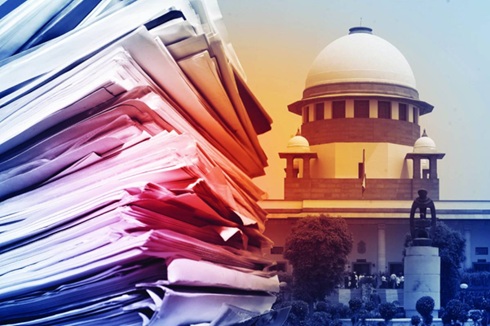(Preliminary exam: Contemporary developments)
(Mains exam, General Studies Paper- 2: Structure, organization and functions of the judiciary; Important aspects of governance, transparency and accountability) |
Reference
As the highest judicial institution of the country, the Supreme Court has the responsibility to provide timely justice to the citizens, but in recent years the number of pending cases in the court has reached record levels. This problem not only puts a question mark on the speed of the justice system but also affects the right of citizens to get justice.

Pending cases in the Supreme Court
- According to the National Judicial Data Grid (NJDG), there are a total of 88,417 cases pending in the Supreme Court as of September 2025.
- These include 69,553 civil and 18,864 criminal cases. This is the highest level ever.
Important Statistics
- In August 2025 itself, 7,080 new cases were filed, while 5,667 cases were disposed of. This means that the disposal rate has been only 80.04%.
- So far in the year 2025, 52,630 cases have been filed, out of which 46,309 (88%) were disposed of.
- The Supreme Court is currently working with its maximum sanctioned strength of 34 judges.
Reasons for Delays
- Increasing number of cases: The filing of new cases every year is more than the cases disposed of.
- Complex and long-term litigation: Many cases are related to technical and constitutional issues, which take more time.
- Excess of government appeals: Excessive appeals by government departments increase the burden.
- Procedural delays: There is a gap in case transfers, documentary formalities and hearing dates.
- Increase in population and economic activities: The pressure on the courts has increased due to the increase in socio-economic disputes
Impact
- Justice Delayed is Justice Denied
- The trust of the common citizen in the judiciary may weaken.
- Delay in resolution of business and economic disputes affects the investment climate.
- Pending criminal cases for prisoners mean that they may remain in jail for a long time, even if they are innocent.
- The workload on judges and staff increases, which may affect the quality.
Challenges
- Excessive burden of cases: Despite regular disposal rate, the backlog is not reducing.
- Limited number of judges: There are more cases than the number of 34 judges.
- Lack of technical infrastructure: The process of e-court and digitalization has not been fully implemented yet.
- Frequent adjournments sought by lawyers: This is the main reason for delay in hearings, which leads to delay in disposal of cases.
- Slow pace of policy change: Alternative dispute resolution (ADR) has not been promoted enough.
What should be done
- Increase in number of judges: Consider appointing more judges under the Constitution
- Use of technology: Implement e-courts, artificial intelligence based case management system
- Fast-track benches: Separate benches for constitutional and urgent matters
- Promotion of alternative dispute resolution (ADR): Encourage mediation, conciliation and arbitration
- Reducing government litigation: Government should adopt 'filter mechanism' to reduce unnecessary appeals
- Simplification of procedures: Arrange for quick hearing and timely decision


